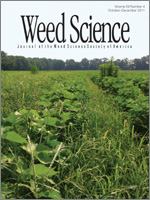Spreading dogbane is an important weed of wild blueberry fields that decreases yields and hinders harvest operations. A range of experiments was conducted to evaluate the impact of abiotic factors on dogbane seed germination. Freshly harvested seeds were largely nondormant with viability ranging between 67 and 84%. Prolonged exposure to light neither promoted nor inhibited germination. Germination rates and total seed germination varied with temperature and osmotic potential. Significantly fewer seeds germinated at 5 C compared with 10, 15, and 20 C. There was a significant quadratic relationship between dogbane germination and osmotic potential, with significant numbers of seeds germinating at levels as low as −0.5 MPa. Emergence rates declined exponentially with depth in the soil and as many as 9% of seeds germinated but were unable to reach the soil surface. Results indicate that substantial seed germination in blueberry fields is possible and primary dispersal without wind occurs over a very short distance.
Nomenclature: Spreading dogbane, Apocynum androsaemifolium L.; wild blueberry, Vaccinium angustifolium Ait.





